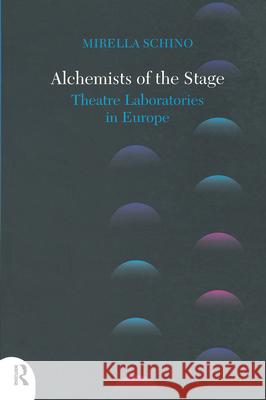Alchemists of the Stage » książka
Alchemists of the Stage
ISBN-13: 9781138456976 / Angielski / Twarda / 2023 / 272 str.
Alchemists of the Stage
ISBN-13: 9781138456976 / Angielski / Twarda / 2023 / 272 str.
(netto: 695,40 VAT: 5%)
Najniższa cena z 30 dni: 724,19
ok. 22 dni roboczych
Bez gwarancji dostawy przed świętami
Darmowa dostawa!
What is a theatre laboratory? Why a theatre laboratory? This book tries to answer these questions focusing on the experiences and theories, the visions and the techniques, the differences and similarities of European theatre laboratories in the twentieth century. It studies in depth the Studios of Stanislavski and Meyerhold, the school of Decroux, the Teatr Laboratorium of Jerzy Grotowski and Ludwik Flaszen, as well as Eugenio Barba‘s Odin Teatret.Theatre laboratories embody a theatre practice which defies the demands and fashions of the times, the usual ways of production and the sensible functions which stage art enjoys in our society. It is a theatre which refuses to be only art and whose radical research forges new conditions with a view to changing both the actor and the spectator. This research transforms theatrical craft into a laboratory which has been compared to the laboratory of the alchemists, who worked not on material but on substance. The alchemists of the stage did not operate only on forms and styles, but mainly on the living matter of the theatre: the actor, seen not just as an artist but above all as a representative of a new human being.Laboratory theatres have rarely been at the centre of the news. Yet their underground activity has influenced theatre history. Without them, the same idea of theatre, as it has been shaped in the course of the twentieth century, would have been different. In this book Mirella Schino recounts, as in a novel, the vicissitudes of a group of practitioners and scholars who try to uncover the technical, political and spiritual perspectives behind the word laboratory when applied to the theatre.
The geographic area covered by this catalog is the Neotropical Region including Mexico, Marginal areas such as the Bahamas Islands, Islas Malvinas, the Juan Fernandez archipelago and Easter Island are also covered. This catalog lists 959 species distributed into 158 genera and presents a complete list of the species that have been reported from this region until August 1, 1989. All reference that deal with the biology or taxonomy of the Neotropical Collembola are included, as well as the fauna of Nearctic areas of Mexico. The catalog incorporates the latest advances in collembolan taxonomy, maintaining a balance between the most conservative and liberal classifications. Under each family or subfamily, the catalog groups genera which are closely related. Under each genus or subgenus it lists the species in alphabetical order.











